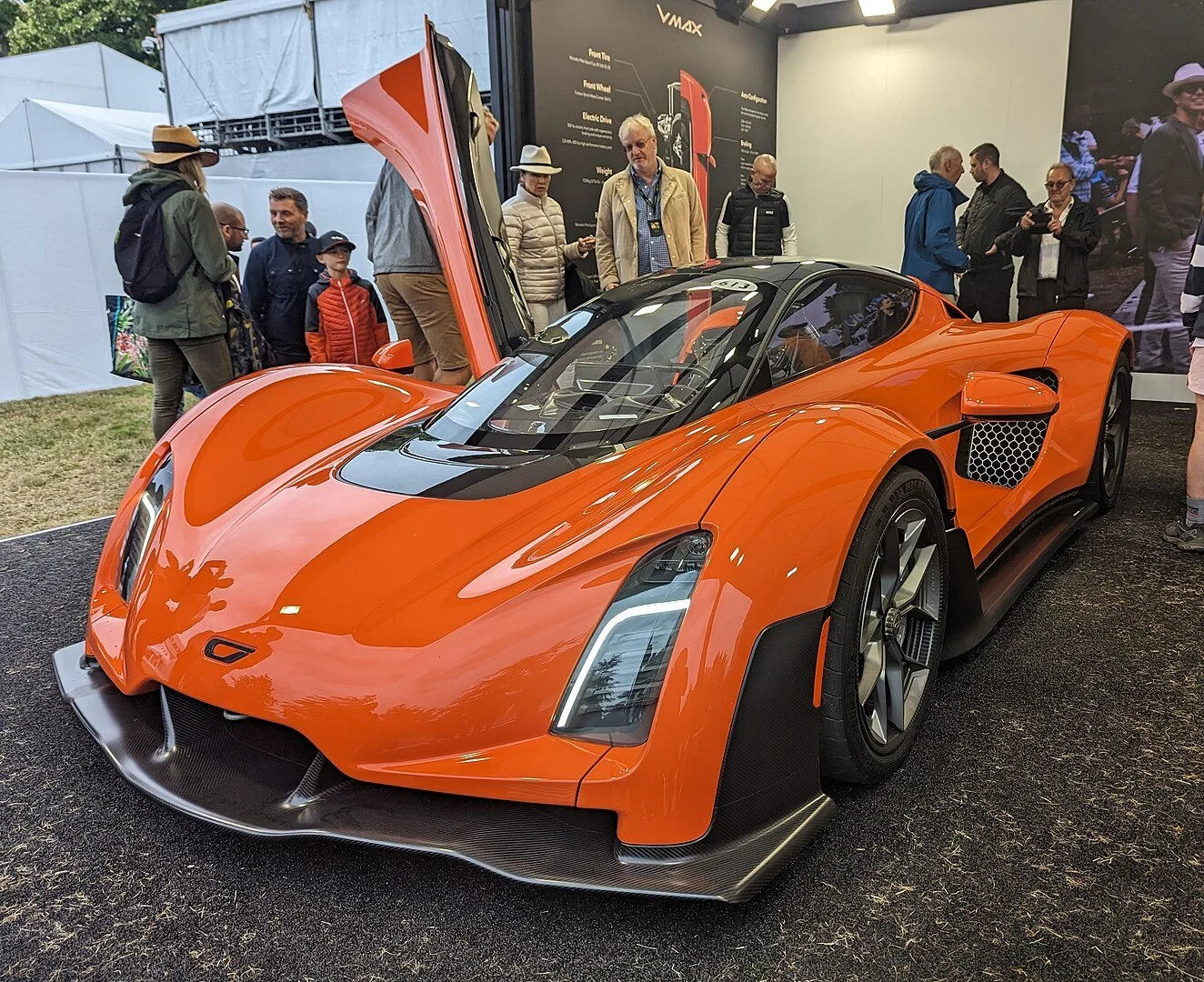Die 10 exklusivsten Hypercars 2025: Limitierte Supermaschinen, die Geschichte schreiben Teil 2
Noch nicht genug von Carbon, PS und Limitierungswahnsinn? Dann bist du hier genau richtig: Im zweiten Teil unseres exklusiven Rankings präsentieren wir dir die Plätze 7 bis 10 der außergewöhnlichsten Hypercars des Jahres 2025. Während sich der erste Teil bereits wie ein Who’s Who der automobilen Elite las, erwarten dich nun vier weitere Modelle, die das Wort „Superlativ“ neu definieren.
Von der Rennstreckendominanz eines Aston Martin Valkyrie AMR Pro über elektrifizierte Zukunftsvisionen von Porsche und Genesis bis hin zu streng limitierten Sammlerstücken, die mehr Investment als Fortbewegungsmittel sind – jedes dieser Fahrzeuge steht für ein neues Kapitel in der Geschichte der Hypercars.
Alle Modelle sind extrem limitiert, technologisch wegweisend und 2025 entweder erstmals erhältlich oder in streng regulierter Auslieferung. Ob vollelektrisch, hybridisiert oder puristisch mit V12 – was sie verbindet, ist die absolute Hingabe an Exklusivität, Ingenieurskunst und emotionale Faszination.
Bereit für Teil 2? Dann schnall dich an – wir gehen in die letzte Kurve unseres Top-10-Rankings der limitiertesten Hypercars 2025.
6. Czinger 21C V Max – Kalifornische Präzision für die Überholspur
Mit dem 21C V Max präsentiert das kalifornische Unternehmen Czinger Vehicles eines der radikalsten Hypercars des Jahres 2025. Entwickelt in Los Angeles und produziert unter Einsatz von 3D-Druck- und KI-optimierter Leichtbauweise, ist der Czinger 21C V Max nicht nur eine technische Demonstration, sondern auch extrem limitiert: nur 80 Exemplare weltweit werden gebaut.
Design: Aerodynamik im Dienst der Geschwindigkeit
Im Gegensatz zur standardmäßigen 21C-Version ist der V Max speziell auf Highspeed-Performance ausgelegt. Die auffälligste Designänderung: Das aggressive Aero-Paket des Track-Modells wird durch eine langgezogene, windschnittige Karosserie ersetzt, die auf maximalen Geradeauslauf optimiert ist.
Design-Features:
Extrem schlanke Linienführung für minimale Luftverwirbelungen
Verlängerter Heckbereich mit integrierter Finne
Minimalistische LED-Lichtbänder vorn und hinten
Verglaste Fighter-Jet-Kanzel mit zentralem Fahrerplatz
3D-gedruckte Strukturteile aus Aluminium-Titan-Legierungen
Antrieb: Hybridkraft mit Rennsportgenen
Der Antriebsstrang ist identisch mit dem Standard-21C, aber für höhere Endgeschwindigkeit kalibriert. Er kombiniert einen 2,88-Liter-V8-Biturbo-Motor mit zwei Elektromotoren an der Vorderachse – und liefert in Summe 1.250 PS bei einem Gesamtgewicht von nur rund 1.250 kg. Das ergibt ein Leistungsgewicht von 1:1.
Technische Daten:
Motor: V8 Bi-Turbo + zwei Elektromotoren (AWD)
Systemleistung: 1.250 PS
0–100 km/h: ca. 1,9 Sekunden
Top-Speed: > 400 km/h
Getriebe: 7-Gang sequenziell mit automatischer Kupplung
Die Hybridbatterie ist für kurzzeitige Leistungsabgabe ausgelegt und unterstützt auch beim Torque Vectoring.
Fahrwerk und Chassis: Intelligent konstruiert
Czinger nutzt ein selbst entwickeltes Fertigungsverfahren namens Additive Manufacturing + Human-AI Design, bei dem Fahrzeugstrukturteile digital optimiert und anschließend im 3D-Druckverfahren hergestellt werden.
Besonderheiten:
Kohlefaser-Monocoque mit integrierter Crashstruktur
Radaufhängung aus 3D-gedrucktem Aluminium
Pushrod-System mit adaptiven Dämpfern
Aktiv geregelte Aerodynamik und Bremsenkühlung
Das Ergebnis ist eine Plattform, die sowohl auf der Geraden als auch in schnellen Kurven höchste Stabilität bietet.
Cockpit: Zentral & kompromisslos
Wie beim Standardmodell sitzt der Fahrer zentral im Fahrzeug – ein Alleinstellungsmerkmal in dieser Fahrzeugklasse. Der Beifahrersitz ist leicht versetzt dahinter angeordnet (Tandem-Konfiguration). Das Cockpit ist minimalistisch, mit Fokus auf Gewicht und Ergonomie.
Highlights im Innenraum:
Volldigitales Renn-Display mit Datenanalyse
Jet-inspiriertes Steuerhorn
Rennsportsitze aus Carbon mit 6-Punkt-Gurten
Reduzierte Bedienung über Multifunktions-Drehregler
Modulare Struktur erlaubt individuelle Konfiguration bei Bestellung
Preis und Verfügbarkeit
Der Einstiegspreis liegt bei über 2 Millionen Euro, je nach Ausstattung. Alle 80 Exemplare sind nach Firmenangaben für 2025 reserviert oder bereits verkauft. Käufer werden zudem zu exklusiven Highspeed-Events auf privaten Teststrecken eingeladen, u. a. in Kalifornien, Dubai und Italien.
Fazit: Ein Hypercar mit Zukunftsblick
Der Czinger 21C V Max ist mehr als nur ein Fahrzeug – er ist ein Statement aus Carbon und Code. Entwickelt in einer der technologieaffinsten Regionen der Welt, vereint er innovative Produktionsmethoden mit brutaler Leistungsentfaltung. Wer ihn fährt, fährt Zukunft – mit über 400 km/h.
7. Aston Martin Valkyrie AMR Pro – Die Speerspitze britischer Track-Tech
Mit dem Valkyrie AMR Pro liefert Aston Martin ein kompromissloses Hypercar, das nicht für den Alltag, sondern ausschließlich für die Rennstrecke gebaut wurde. Die „AMR Pro“-Variante stellt die radikalste Evolutionsstufe des ursprünglichen Valkyrie-Konzepts dar – ohne Straßenzulassung, aber mit enormem Potenzial. Nur 40 Fahrzeuge weltweit werden gebaut.
Entwicklung: Von Le Mans inspiriert
Der AMR Pro basiert auf dem ursprünglichen Valkyrie-Prototypen für das geplante Le-Mans-Hypercar-Programm. Nach der Projektänderung entschied sich Aston Martin, die Technik in ein reinrassiges Track-Car zu überführen. Das Ergebnis: ein kompromissloser Bolide mit Technologien, die direkt aus dem LMP1-Reglement abgeleitet sind.
Antrieb: V12 pur – ohne Kompromisse
Im Gegensatz zur Straßenversion verzichtet der AMR Pro vollständig auf das Hybridsystem. Stattdessen sorgt ein hochdrehender, 6,5-Liter-V12-Saugmotor, entwickelt in Kooperation mit Cosworth, für den Vortrieb. Dieser leistet über 1.000 PS und dreht bis auf 11.000 U/min – ein Sounderlebnis der Sonderklasse.
Technische Highlights:
Motor: 6,5-Liter V12 Saugmotor
Leistung: >1.000 PS
Höchstgeschwindigkeit: über 350 km/h
0–100 km/h: unter 2,5 Sekunden
Gewicht: ca. 1.000 kg
Getriebe: sequentielles 7-Gang-Renngetriebe
Das Leistungsgewicht liegt unter 1,0 kg/PS – vergleichbar mit einem modernen LMP1-Rennwagen.
Fahrwerk und Aerodynamik: Ein mobiles Windtunnelmodell
Die Aerodynamik des AMR Pro wurde mithilfe von Computational Fluid Dynamics (CFD) und Windkanaltests extrem feinjustiert. Das Ergebnis: mehr als das Doppelte an Abtrieb im Vergleich zur Straßenversion.
Technische Features:
Riesiger Heckflügel mit variabler Geometrie
Splitter- und Diffusorpaket mit DRS-Funktion
Push-Rod-Aufhängung mit aktiver Dämpfung
Rennreifen von Michelin in Sonderausführung
Zusätzlich wurde der Radstand verlängert, die Spur verbreitert und die Fahrhöhe abgesenkt – alles mit dem Ziel, maximalen Grip bei maximaler Stabilität zu erzeugen.
Innenraum: Cockpit wie ein LMP1
Im Gegensatz zur Straßenversion wurde das Cockpit des AMR Pro stark reduziert und an das Layout eines modernen Le-Mans-Prototyps angepasst. Ziel: Maximale Konzentration und Ergonomie für Trackdays und professionelle Einsätze.
Ausstattungsdetails:
Racing-Sitzschalen mit 6-Punkt-Gurten
Multifunktionslenkrad mit Race-Setup-Wählern
Telemetrie-Display mit Datenaufzeichnung
FIA-konformes Sicherheitszellenkonzept
Die Sitzposition erinnert stark an einen Formelwagen – halb liegend, mit ausgestreckten Beinen und tiefem Schwerpunktgefühl.
Preis und Exklusivität
Mit einem Einstiegspreis von über 3 Millionen Euro ist der Valkyrie AMR Pro nicht nur eines der exklusivsten Fahrzeuge 2025, sondern auch eines der kompromisslosesten. Alle 40 Exemplare sind nach Unternehmensangaben bereits vergeben – meist an Rennteams, Sammler oder besonders engagierte Aston-Martin-Kunden.
Fazit: Rennsport ohne Filter
Der Valkyrie AMR Pro ist das, was entsteht, wenn man Motorsport-Ingenieuren freie Hand gibt. Keine Straßenzulassung, keine Rücksicht auf Komfort – nur Geschwindigkeit, Aerodynamik und Leistung pur. Ein fahrbarer Beweis dafür, wie nah moderne Track-Only-Hypercars an die Welt des professionellen Rennsports heranrücken können.
8. Porsche Mission X – Der elektrische Aufbruch in neue Hypercar-Sphären
Mit dem Mission X kündigt Porsche für 2025 ein vollelektrisches Hypercar an, das nicht nur als technisches Flaggschiff dienen soll, sondern auch ambitionierte Ziele verfolgt: Es will das schnellste straßenzugelassene Fahrzeug auf der Nürburgring Nordschleife werden – elektrisch. Die Stückzahl wird streng limitiert, konkrete Zahlen nennt Porsche bislang nicht, Experten gehen jedoch von unter 100 Exemplaren aus.
Design: Skulptur mit Rennsport-DNA
Der Mission X wurde von Porsche als futuristische Hommage an den legendären Porsche 959 und den Carrera GT konzipiert. Seine Form ist geprägt von einer flachen Silhouette, einem dramatisch gespannten Heckdiffusor und einem durchgehenden Leuchtenband.
Besonderes Highlight: Die vertikal öffnenden Le-Mans-Türen im Butterfly-Stil, ein klarer Hinweis auf den Motorsportanspruch.
Weitere Designmerkmale:
Komplette Leichtbau-Karosserie aus CFK
20-Zoll-Front- und 21-Zoll-Heckfelgen im Turbinendesign
Aerodynamisch integrierte Seitenspiegelkameras
Illuminierter Porsche-Schriftzug im Heckbereich
Antrieb und Performance: Elektrisch, aber brutal
Die endgültigen Leistungsdaten wurden noch nicht offiziell veröffentlicht, aber Porsche hat die Eckpunkte bereits umrissen: Der Mission X soll ein Leistungsgewicht von unter 1:1 (kg/PS) erreichen und eine Ladeleistung von bis zu 900 Volt bieten – mehr als jedes bisherige Serienfahrzeug.
Geplante Leistungsmerkmale:
Antrieb: rein elektrisch mit Dual-Motor-Konfiguration
Systemleistung: geschätzt >1.000 PS
Top-Speed: über 350 km/h
0–100 km/h: unter 2,5 Sekunden
Akku: Hochleistungsbatterie mit Leichtbau-Modultechnik
Ladeleistung: bis zu 900 Volt (ultraschnelles Laden)
Fahrwerk und Dynamik: Nordschleifen-tauglich
Der Mission X soll ein Fahrverhalten bieten, das sich nicht nur mit Hypercars, sondern auch mit modernen GT-Rennwagen messen kann. Dazu zählen ein aktives Fahrwerkssystem, Torque Vectoring, sowie eine adaptive Aerodynamik, die an die jeweiligen Geschwindigkeiten und Streckenbedingungen angepasst wird.
Fahrwerk-Features:
Adaptive 3-Kammer-Luftfederung mit Track-Modus
Mehrlenker-Achskonstruktion aus Aluminium-Schmiedeteilen
Bremssystem mit regenerativer Rückgewinnung und Keramikscheiben
Dynamisches Stabilisatorensystem für Kurvenpräzision
Innenraum: Funktion trifft Eleganz
Im Cockpit des Mission X herrscht ein Mix aus Sportlichkeit und futuristischem Design. Zwei verschiedene Sitzkonfigurationen sind geplant – eine puristische Rennversion und eine edle „Heritage“-Ausführung.
Ausstattungsdetails:
Asymmetrisches Digitalcockpit mit Telemetrieintegration
Kombiinstrument mit variablem Layout für Straße und Track
Recycelte Hightech-Materialien mit Alcantara-Akzenten
Gestengesteuerte Touch-Elemente und Sprachsteuerung
Exklusivität und Ausblick
Der Mission X wird nicht nur als Showpiece, sondern als reales Serienmodell in kleiner Stückzahl produziert. Porsche bezeichnet ihn als „Technologieträger für kommende Generationen“. Der Preis dürfte oberhalb der 2,5 Millionen Euro liegen.
Die offizielle Vorstellung der Serienversion wird für Herbst 2025 erwartet, erste Kunden sollen im späten 2025/Frühjahr 2026 beliefert werden.
Fazit: Die elektrische Antwort aus Zuffenhausen
Der Porsche Mission X markiert den Einstieg der Marke in die neue Ära vollelektrischer Hypercars – ohne dabei die DNA von Porsche zu verleugnen. Ein Auto, das Leistungsstärke, Ingenieurskunst und Exklusivität auf faszinierende Weise vereint. Und ein klares Zeichen, dass auch die Zukunft des Hypercar-Segments auf elektrischer Basis extrem aufregend bleibt.
9. Genesis GMR-001 – Korea betritt die Bühne der Hypercars
Mit dem GMR-001 präsentiert Genesis – die Luxusmarke von Hyundai – erstmals ein Fahrzeug, das gezielt für die Teilnahme an der Langstrecken-Weltmeisterschaft (WEC) entwickelt wurde und zugleich als ultraexklusives Hypercar für Sammler erhältlich sein soll. Die Serienproduktion ist extrem limitiert, erste Auslieferungen an Kunden sind für Ende 2025 geplant.
Design: Futuristisch und martialisch zugleich
Genesis verlässt mit dem GMR-001 bewusst den Designpfad der eigenen Limousinen- und SUV-Modelle. Der GMR-001 zeigt sich als kompromisslos aerodynamisch geformter Mittelmotor-Hypercar mit sichtbaren Karbonelementen, Kiemen, Finnen und massiven Diffusoren.
Gestaltungsmerkmale:
Monocoque aus Sichtcarbon mit integriertem Halo-Schutzsystem
Split-Wing-Design mit aerodynamischer Finne
Zwei-Element-Heckspoiler mit aktivem Downforce-Management
Laserlicht-Front mit LED-Intarsien im asiatisch-futuristischen Stil
Antrieb: Hybridtechnik mit Motorsport-DNA
Der GMR-001 kombiniert einen hochdrehenden V8-Biturbo-Benzinmotor mit einem elektrischen Frontantrieb, der speziell für den Einsatz im WEC entwickelt wurde. Die Systemleistung wird auf über 1.000 PS geschätzt.
Antriebskomponenten:
Motor: 4,2-Liter V8 Twin-Turbo mit Trockensumpfschmierung
E-Motor: integrierte E-Achse vorn mit regenerativem Bremssystem
Systemleistung: ca. 1.050 PS
Antrieb: Allrad mit aktiver Drehmomentverteilung
Getriebe: sequentielles 7-Gang-Renngetriebe mit Paddle-Shift
Die gesamte Antriebseinheit ist so abgestimmt, dass sie mit E85-Rennkraftstoff oder Wasserstoff-Derivaten betrieben werden kann – ein technologischer Ausblick auf kommende Motorsportformate.
Fahrwerk und Technik: Koreanische Präzision
Genesis setzt beim GMR-001 auf ein komplett neues Fahrwerkskonzept, das unter Beteiligung europäischer Rennsportingenieure entwickelt wurde. Die Zielsetzung: kompromisslose Performance auf der Strecke und technologische Exzellenz im Detail.
Fahrwerkstechnologien:
Elektronisch geregeltes Pushrod-System
Karbon-Bremsanlage mit Vierfach-Kühlsystem
Integrierte Telemetrie- und Datenauswertungseinheit
Vierfach verstellbares Aerodynamikpaket für Langstrecke, Sprint, Regen und Qualifikation
Innenraum: Hightech trifft asiatische Designphilosophie
Das Cockpit ist klar auf den Fahrer zentriert und kombiniert Funktionalität mit luxuriösen Details. Genesis legt besonderen Wert auf haptisches Feedback und ein Interface, das sich dem Fahrmodus dynamisch anpasst.
Innenraumdetails:
OLED-Instrumenten-Cluster mit kontextabhängiger Anzeige
Schalensitze mit Nanoleder und Magnetresonanzpolsterung
Personalisierbares Licht- und Klangsystem
AI-basierte Fahrerassistenz für Streckenerkennung und Laptime-Optimierung
Exklusivität und Marktpositionierung
Genesis hat angekündigt, dass der GMR-001 in einer extrem kleinen Stückzahl produziert wird – Schätzungen gehen von 30–50 Fahrzeugen weltweit aus. Die Fahrzeuge sollen nur auf Einladung verkauft werden und sind in der Regel an ein exklusives WEC-Fahrprogramm gebunden.
Der Preis liegt ersten Informationen zufolge bei über 2,7 Millionen Euro, wobei individuelle Anpassungen, Rennstreckenzugang und Wartungspakete inbegriffen sind.
Fazit: Der stille Herausforderer
Der Genesis GMR-001 könnte sich als die größte Überraschung im Hypercar-Jahr 2025 erweisen. Mit kompromissloser Technik, mutigem Design und Rennsportfokus hebt sich das koreanische Debüt deutlich vom Mainstream ab – und signalisiert, dass die Welt der Hypercars längst keine westliche Domäne mehr ist.
10. Aston Martin Valhalla – Hybridkraft aus Gaydon mit Formel-1-Genetik
Der Valhalla ist Aston Martins nächster großer Wurf im Hypercar-Segment. Nach dem radikalen Valkyrie bringt der britische Hersteller mit dem Valhalla 2025 ein Fahrzeug, das die Lücke zwischen Rennstrecke und Straße schließen soll – mit limitiertem Produktionsvolumen von unter 500 Einheiten.
Design: Funktion und Ästhetik im Gleichgewicht
Optisch bleibt der Valhalla der markentypischen Linienführung treu, kombiniert aber ein modernes, windkanalgetestetes Aero-Konzept mit klassischen Aston-Martin-Proportionen. Die Karosserie ist vollständig aus Karbon gefertigt und verfügt über zahlreiche aktive Aerodynamik-Elemente.
Design-Highlights:
Zwei-geteilter aktiver Frontsplitter
Flexibler Heckdiffusor mit adaptiven Klappen
Schmale Matrix-LED-Leuchten
Dihedral-Türen im Le-Mans-Stil
Dachlufteinlass für zentrale Motorkühlung
Antrieb: Hybrid-Power auf Formel-1-Niveau
Im Heck des Valhalla arbeitet ein 4,0-Liter-V8-Biturbo-Motor, der gemeinsam mit AMG entwickelt wurde, kombiniert mit zwei Elektromotoren – einer pro Achse. Die Systemleistung liegt bei über 1.000 PS.
Technische Eckdaten:
Motor: 4,0-Liter V8 Twin-Turbo + zwei E-Motoren
Systemleistung: ca. 1.012 PS
0–100 km/h: unter 2,5 Sekunden
Top-Speed: >350 km/h
Getriebe: 8-Gang-Doppelkupplung mit integriertem e-Diff
Antrieb: Allrad mit Torque Vectoring
Das System basiert auf Technologien aus der Formel 1 – inklusive elektrischem Boost, regenerativem Bremsen und Launch-Control-Strategien.
Chassis und Dynamik: Auf die Strecke abgestimmt
Das Chassis besteht aus einem ultraleichten Karbon-Monocoque. Das Fahrwerk ist doppelt querlenkergeführt mit adaptiver Dämpfung und variabler Fahrhöhe – entwickelt mit Input des Aston-Martin-F1-Teams.
Performance-Komponenten:
Aktive Aerodynamik mit bis zu 600 kg Downforce
Carbon-Keramik-Bremsen mit Track-Bremssätteln
21-Zoll-Schmiederäder mit Center-Lock-System
Performance-Reifen mit F1-Mischung
Innenraum: Motorsport trifft Komfort
Im Cockpit treffen Performance-Materialien auf eine klare Fahrerfokussierung. Die Sitze sind tief montiert und bieten bestmögliche Unterstützung, während das HMI-System mit einem gebogenen OLED-Display modernste Infotainment-Integration bietet.
Ausstattungshighlights:
Lenkrad mit integrierten Fahrmodi
Cloudbasierte Streckenanalyse & Performance-Logging
Adaptive Sitze mit Memory- und Heizfunktion
Wireless-Integration für Smartphone und HUD-System
Exklusivität und Marktstrategie
Die Produktion des Valhalla ist auf unter 500 Fahrzeuge limitiert. Die ersten Auslieferungen beginnen im zweiten Halbjahr 2025. Der Einstiegspreis liegt bei über 800.000 Euro, kann je nach Sonderwunsch aber deutlich höher ausfallen.
Fazit: Brückenschlag zwischen Straße und Rennstrecke
Der Aston Martin Valhalla ist ein faszinierendes Hybrid-Hypercar mit klarem Fokus auf Performance und Alltagstauglichkeit. Er bringt die Technik des Motorsports auf die Straße – in limitierter Stückzahl und mit einem Design, das britische Eleganz mit aerodynamischer Effizienz vereint. Ein echter Meilenstein auf dem Weg in die Hybrid-Zukunft von Aston Martin.
👉Was dir in Zusammenhang mit diesem Beitrag auch gefallen könnte:
Technologische Meisterwerke: Die innovativsten Features moderner Hypercars
Die seltensten Hypercars aller Zeiten: Limitierte Meisterwerke der Automobilkunst Teil 1
Die seltensten Hypercars aller Zeiten: Limitierte Meisterwerke der Automobilkunst Teil 2





